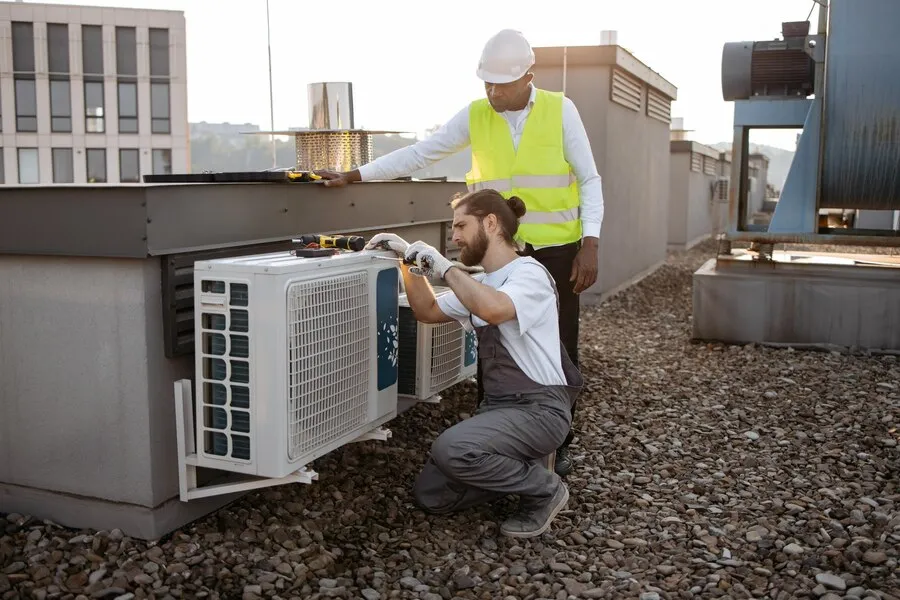Key Takeaways:
- Technological advancements have revolutionized air conditioning efficiency and user-friendliness.
- The SEER rating is an essential factor for evaluating cost-effectiveness and environmental impact.
- Routine maintenance plays a crucial role in the longevity and efficiency of AC systems.
- Professional installation is fundamental for ensuring optimal performance and safety.
- The future of air conditioning technology is leaning towards sustainability and advanced integrations.
The Evolution of Air Conditioning Technology
Over the decades, air conditioning technology has transformed, reshaping our approach to comfort and efficiency in climate control. Sleek, whisper-quiet, energy-conscious models now replace the bulky, noisy, and power-hungry units of the past. This journey, from simple ice blocks and electric fans to modern central air systems, is a testament to human ingenuity. These significant technological leaps forward have been crucial in making AC systems more accessible and efficient, affecting everything from residential homes to large commercial spaces.
Benefits of Modern Air Conditioning Systems
Today’s air conditioning systems offer numerous advantages to the consumer. With the world experiencing unprecedented temperatures, a robust and effective cooling system is no longer a luxury but a necessity. The benefits of modern AC systems extend well beyond mere comfort. They blend efficiency and technological integration, reducing utility bills and lowering carbon footprints. Furthermore, incorporating smart thermostats into these systems has added convenience, allowing homeowners to adjust and monitor their climate settings remotely and optimize energy usage for varying conditions.
Key Features to Look For in Contemporary AC Installations
When homeowners are poised to make the crucial decision regarding air conditioning installation, there are certain features they should look out for to ensure they are getting a state-of-the-art system. These include high Seasonal Energy Efficiency Ratio (SEER) ratings, which correlate with the unit’s energy consumption and integrate smart home technologies that provide enhanced usability and energy management features. Another essential aspect is the unit’s ability to improve indoor air quality, a growing concern for many individuals seeking healthier home environments.
Understanding SEER Ratings and Their Impact on Cost Savings
The Seasonal Energy Efficiency Ratio, or SEER rating, is the metric by which the efficiency of air conditioning units is gauged. It reflects how much cooling an AC unit can provide per unit of electricity it consumes over a typical cooling season. The higher the SEER rating, the less energy the unit will consume, translating into lower energy bills for the homeowner. While units with higher SEER ratings typically have higher upfront costs, the long-term savings on energy bills can make these options financially appealing. Additionally, environmentally conscious consumers often choose higher-rated units to minimize their ecological footprint.
The Process of Professional Air Conditioning Installation
Installing an air conditioning system is complex beyond simply placing a unit and turning it on. During professional air conditioning installation, experts focus on the heating & cooling needs of the space to ensure efficient and optimal climate control throughout the property. Professional installers will thoroughly evaluate the home, considering factors such as the size of the area to be cooled, the local climate, and the home’s insulation levels. Then, they proceed with the detailed technical work, ensuring the unit is correctly sized and optimally placed to function efficiently. This is why engaging a certified professional becomes imperative – the precision and care taken during installation are instrumental in ensuring that the system functions at peak efficiency and adheres to all safety and warranty guidelines set by the manufacturer.
Maintenance Tips to Extend the Life of Your Air Conditioning Unit
Routine maintenance becomes the cornerstone of an air conditioning unit’s longevity and efficiency post-installation. Proper care involves:
- Regular cleaning of air filters.
- Checking and unclogging the condensate drain.
- Ensuring the outdoor components are debris-free.
Homeowners should also schedule professional maintenance services at least once a year before peak cooling season. These service checks often include refrigerant level adjustments, duct leakage tests, and electrical connection inspections, all contributing to the unit’s optimal performance throughout its lifespan.
DIY vs Professional AC Installation: Understanding the Risks and Benefits
With many online tutorials at their fingertips, some homeowners might entertain the notion of a DIY air conditioning installation. While this may seem cost-effective initially, it risks overlooking essential elements such as electrical wiring, proper sizing, and secure mounting. On the other hand, professionals bring a wealth of expertise, ensuring that the installation is executed safely and effectively. Certified technicians also ensure that warranties remain valid and that systems comply with local and federal regulations. Given the complexity of modern AC systems, professional installation is often the most reasonable and secure option.
Financial Considerations of Upgrading to a New AC System
Upgrading a newer, more efficient air conditioning system can involve a notable financial outlay. Nevertheless, homeowners must consider critical factors like energy savings, improved home value, and potential incentives for energy-efficient upgrades. Opting for high-efficiency models may qualify for energy rebates, offsetting the initial cost. Additionally, various financing options can make the transition less burdensome, allowing homeowners to spread the cost over time while immediately benefiting from increased comfort and lower energy bills.

